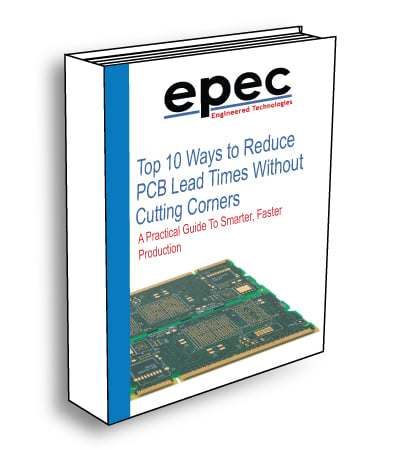PCB Surface Finish Options
Not all circuit board surface finishes are alike. In order for a PCB engineer to specify which surface finish is right for the application, you need to look deeply into what the PCB will be exposed to during its lifetime.
Something as small as the amount of hand soldering or potential field repairs will play a big role in your choice of the best surface finish for your printed circuit board. For additional information, we also have a technical article on the advantages and disadvantages of surface finishes that will help with the selection for your PCB design.
Below are some of the detailed parameters of the most common surface finishes used in the PCB industry.
| Tin Lead HASL | ENIG | Ni & Hard Au | OSP | Immersion Silver | Immersion Tin | |
|---|---|---|---|---|---|---|
| Lead Free HASL | ENEPIG | Ni & Soft Au | ImAg | |||
| Design Attribute | ||||||
| Hole Compensation | Require 0.002 - 0.003 in. | STD | 0.001 in. / Design Dependent | STD | STD | STD |
| Minimum Cleared Hole Size | max 6:1 aspect ratio * | No Limitation | No Limitation | No Limitation | No Limitation | No Limitation |
| Via Caps (post surface finish) | UV / Thermal | UV / Thermal | UV / Thermal | UV only | UV | UV only |
| Electrical Contact Use | Fair | Good for Low Wear Applications | Hard Au: Excellent Soft Au: Not Recommended |
Not Recommended | Good for Low Wear Applications | Good for Low Wear Applications |
| SMOBC | Only | SMOBC = Yes Pre sm = design dependent |
Yes if Tie bar | Only | Only | Only |
| Exposed Copper | None | None | Trace Edges (if not tie bar) | Un-assembled features after assembly | None | None |
| Manufacturing Process | ||||||
| Process Automation | Conveyorized or Vertical | Vertical only | Vertical | Conveyorized | Conveyorized or Vertical | Conveyorized or Vertical |
| Environmental & Process Hazards | High (Lead & Thermal) | Medium | Medium | Low | Low | High (Thiourea) |
| Quality Concerns | QFP Shorting / uBGA / Flatness | Skip/Extraneous Plate | Resist Lifting Plating Distribution |
Handling | Handling | SM Attack / Handling |
| Gold Contacts | Tie bar ok Other: Design dependent |
Low volume / Tie Bar | Thin Hard Au solderable Thick Hard Au for contact Thick Soft Au for Au wire bonding |
No Limitation | Design Dependent (masking consideration) |
Tie bar ok Other: Design Dependent |
| Finished PCB Rework Ability | Design Dependent | ENIG: Limited to Ni & Au brush ENEPIG: Unknown |
Limited to Nickel & Gold brush | Easy | Limited | Medium |
| Equipment Maintenance | Intensive | Typical Vertical Process | Typical Vertical Process | Low | Low | Low |
| Thickness Measurement | XRF on Product | XRF on Product | XRF on Product | Spectrophotometer on Test Coupon | XRF on Product | XRF on Product |
| Manufacturability | Tin-Lead: 2 Lead-Free: 3 |
ENIG: 4 ENEPIG: 5 |
3 | 1 | 1 | 3 |
| Assembly Considerations | ||||||
| Thickness Deposit | 50 to 1500 uin IMC layer and planarity consideration |
ENIG:2 to 6 uin Au / 150 to 250 uin Ni ENEPIG wide range (being defined by IPC committee) |
Hard Au for solderability 5 to 15 uin Hard Au for contacts 30 to 50 uin Soft Au for wire bonding 40+ uinover a minimum of 150 uin of Ni |
6 to 24 micro-inch chemistry dependent | 6 to 18 uin | 30 to 40 uinch minimum |
| Features Spacing | Less than 20 mils QFP = Limited | No limitation for SMOBC Preferably > 4 mils prior to SM |
Line width & space and aspect ratio limitation | No Limitation | No Limitation | No Limitation |
| Solder Paste Misprint | Normal Wipe Down | Normal Wipe Down | Normal Wipe Down | Reduces Hold Times between Reflows | Supplier guidelines (cleaner restrictions) | Normal Wipe Down |
| Lead Free Assembly Compatible | Tin-lead: No Lead Free: Yes |
Yes | Yes | Yes The newer generations |
Yes | Limited to the number of reflow cycle |
| Other Considerations | ||||||
| Intermetallic Layer | Tin Copper | ENIG: Tin-Nickel ENEPIG: Tin- Palladium |
Tin-Nickel | Tin Copper | Tin Copper | Tin Copper |
| Solder Joint Strength | Good for Tin-lead Limited data for lead free |
ENIG: Good (Large BGA Issues) | Good | Excellent | Excellent | Good |
| Surface Finish Durability | Tin-lead: Good Lead Free: Unknown |
Very Good | Very Good | Handling considerations | Handling and storage conditions | Good |
| Various | Thermal shock (preheat and solder bath) Lead Free: pre baking |
ENIG: Ni layer for RF applications ENEPIG: Good for Au wire bonding |
Nickel Layer for RF application | Holding time between assembly cycles | Storage, exposure to sulfur and halides | >Limited reflow cycle capability >Good for back plane applications >Intermetallic layer |
* Equipment dependent
For more information on surfaces finishes, see our blog post titled Why Is PB Free HASL A Hassle.
Watch Our Video
Hot Air Solder Leveling (HASL) Explained: How It Protects PCB Finishes
Not Sure What Surface Finish Is Your Best Option?
Make informed decisions for your PCB surface finish after consulting our engineering experts to help you choose wisely and optimize longevity.
Request a Quote Request Design Support Request More Information



